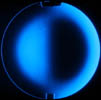

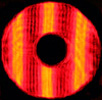

Dec 10, 2012: A 50" f/4 is born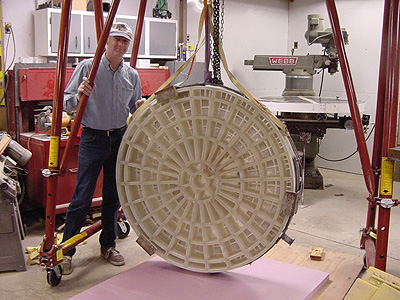 A 50" telescope is not a small one, but for Bob Holmes of the Astronomical Research Institute, a larger instrument was necessary to continue to do the work that he does - the precise measurement of the position of (often faint) asteroids and near-Earth objects (NEOs). To my knowledge, this is the largest amateur-built research instrument in the world, and at the time of its completion was the largest amateur instrument in the world. Bob was very fortunate to be able to obtain a 50" cast cellular blank. Recently, suppliers of these types of blanks have been... shall we say.... less than reilable. The blank was of fairly good quality, but preliminary measurements showed it was out of round by about 1/2"! The photo at right shows Bob with the blank held up by my rolling gantry crane in the shop of JPAstrocraft.com, owned by John Pratte. I loaned the crane to them in order to safely lift and move the blank, and John used his large mill to do the machining and generating work on the blank. 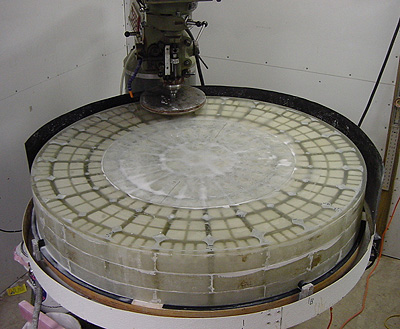 When
they come out of the mold, these blanks are only roughly dimensioned.
So, first, the blank was measured, in particular the thickness of
the front face that would become the optical surface. The mirror was
placed face up on a custom made fixture on top of a large rotary table
on a large mill, and was shimmed so that the underside of the front face was
level. The outer part of the top, near the edge/rim, was machined lightly in order
to provide a reference surface. When
they come out of the mold, these blanks are only roughly dimensioned.
So, first, the blank was measured, in particular the thickness of
the front face that would become the optical surface. The mirror was
placed face up on a custom made fixture on top of a large rotary table
on a large mill, and was shimmed so that the underside of the front face was
level. The outer part of the top, near the edge/rim, was machined lightly in order
to provide a reference surface.Next, the mirror was flipped over and the back was machined flat and parallel to the reference surface. Thus, when the mirror was turned back over so the optical face could be machined, the generation would then leave the face of the mirror with an approximately uniform thickness. Areas were machined on the sides of the blank where the mirror cell edge supports would contact it. The whole outer diameter could not be machined because doing so would seriously thin and weaken the outer rim on the wider axis of the blank. It would also have taken a lot of time. Finally, with the blank centered on the rotary table, a bevel was machined at the edge. It varied in width, but this operation created a round optical surface that was centered on both axes of the asymmetric blank. Using the edge of the optical surface, which was round, I could then center it on my machine for optical work. 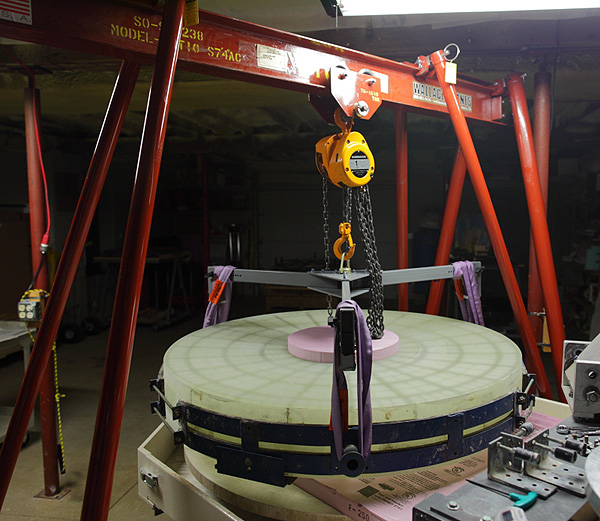 With
the blank machined, it was delivered to my shop and I placed it on the
machine for grinding. The lifting method can be seen in the
photo at right, but it took a long time to install and remove the
lifting band. A better method would be implemented later. With
the blank machined, it was delivered to my shop and I placed it on the
machine for grinding. The lifting method can be seen in the
photo at right, but it took a long time to install and remove the
lifting band. A better method would be implemented later.I could not know what the structural effect of the non-round blank would be, and I could only proceed with work and find out. Grinding progressed reasonably well until the fine grinding, when the epoxy on a number of tiles failed and they came off of the grinding tool. Luckily, the mirror was basically undamaged by this, so I cleaned up and decided to polish the mirror and see what I had. After some polishing, though, the test stand had not yet been modified to hold the cellular mirror using a double cable sling for edge support. 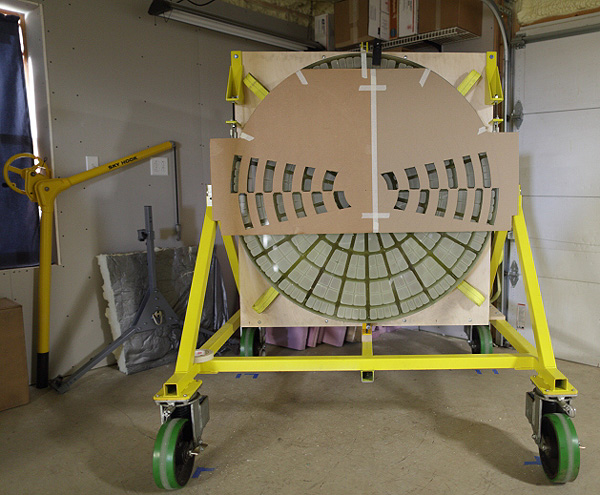 While
waiting for the stand (pictured at left), priorities suddenly changed
(as they sometimes do). With little time to spare, I completed a
30" f/3 mirror for Bob, which was then installed in his third
telescope, replacing a defective set of 30" R-C optics with a prime
focus Newtonian system (like his 24" and his 32" telescopes).
The story of the 30" f/3 can be found in this installment of "In the Shop". While
waiting for the stand (pictured at left), priorities suddenly changed
(as they sometimes do). With little time to spare, I completed a
30" f/3 mirror for Bob, which was then installed in his third
telescope, replacing a defective set of 30" R-C optics with a prime
focus Newtonian system (like his 24" and his 32" telescopes).
The story of the 30" f/3 can be found in this installment of "In the Shop".As it turned out, after polish, the 50" had a highly astigmatic figure. So, the grinding tool was remade with more epoxy, and the mirror was re-ground. This eliminated the gross astigmatism, which was probably machined in and not removed by the first poor grinding tool. These things happen with large mirrors - it's just reality. However, local work was still necessary to reduce some astigmatism after the second polishing (and it also later reappeared during figuring). It became clear at this time that due to the rib thickness varying due to the non-round nature of the blank, the blank was flexing asymetrically during work, helping to create some of the astigmatism. It was also flexing on the test stand in an unknowable way due to the asymmetric structure of the blank. Thus, the mirror was likely going to have some astigmatism that could only be easily detected in the actual cell/telescope. At that point, though, it could easily be reduced by applying a little bit of force to the back of the mirror, just like in the 200" Palomar telescope, also a cast cellular mirror. 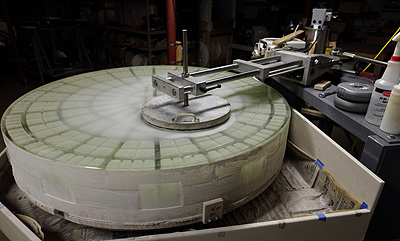 Further
improvements were made to the test stand and cable sling throughout the
work, improving the repeatability of measurements. However, the
asymmetric blank effects remained. Further
improvements were made to the test stand and cable sling throughout the
work, improving the repeatability of measurements. However, the
asymmetric blank effects remained.I removed as much astigmatism as possible and then figured the mirror to an excellent figure, minimizing astigmatism as I went along. A photo of some final figuring work is shown at left here. As of the writing of this, the mirror is crated, uncoated, and ready to be installed in Bob's telescope. 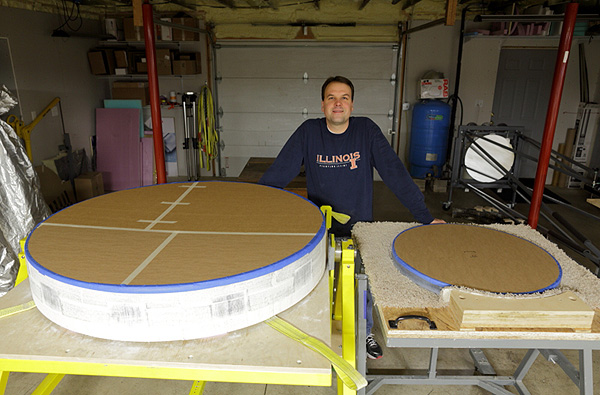 The
image at left shows me with the finished 50" mirror on the test stand
on the left, with the surface protected with acid-free paper and cardboard. For comparison and scale, on the
right is a finished 28" mirror, which is now in
Australia. The
image at left shows me with the finished 50" mirror on the test stand
on the left, with the surface protected with acid-free paper and cardboard. For comparison and scale, on the
right is a finished 28" mirror, which is now in
Australia.The 50" mirror weighs approximately 500 lbs. The 28" mirror weighs around 86 lbs. Large mirrors like this obviously require special equipment for safe handling. |
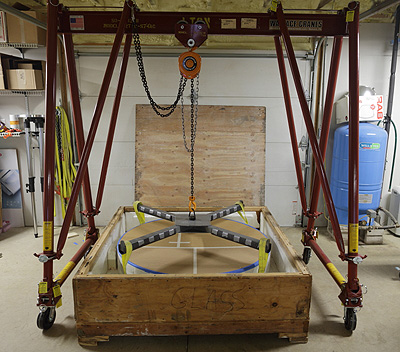 At
right is a photo of the 50" being placed in its crate. Note the
new lifting arrangement with a four-armed spreader (made by Bob Holmes)
with stout yellow straps running under the mirror. This
lifting method was adopted before figuring began because it was much
faster to lift the mirror in this manner than to use the previous metal
band, and probably safer. At
right is a photo of the 50" being placed in its crate. Note the
new lifting arrangement with a four-armed spreader (made by Bob Holmes)
with stout yellow straps running under the mirror. This
lifting method was adopted before figuring began because it was much
faster to lift the mirror in this manner than to use the previous metal
band, and probably safer.Of course, with a mirror ready for testing and delivered to Bob's observatory, the weather turned terrible (the curse of the new mirror). It got cold, snowed, was very windy for quite some time, then it thawed and the ground was too muddy to get the mirror to the observatory. I was hoping to hear first light reports during my trip to the Winter Star Party, but it was not to be. The mirror testing will have to wait a bit longer. Here is a link to Bob's 50" telescope page. |
|
Update, March 2013: I gave a talk (link to my talks and articles) about this work at the Winter Star Party, called "Adventures in Large Mirror Making". I covered the good, bad, and ugly. I'm not afraid to show what happens when things go wrong with a mirror so long as I show how they were made right. As it turns out, there is slight astigmatism in the images of the 50" telescope, which was expected, but it does not affect the in-focus image that the CCD camera sees. So, while we may still try to pull on the mirror as an experiment, it isn't really necessary. The mirror cell itself still likely needs some more adjustment, so things may get better just by doing that. To conclude, I'm amazed by Bob's gigantic instrument, and I am very pleased with how the mirror turned out, especially when considering that it's not even round! Below is a preview - the 50" scope is held vertical by straps so that the primary mirror can be installed and tested. This will be covered in an upcoming installment of "In the Shop". 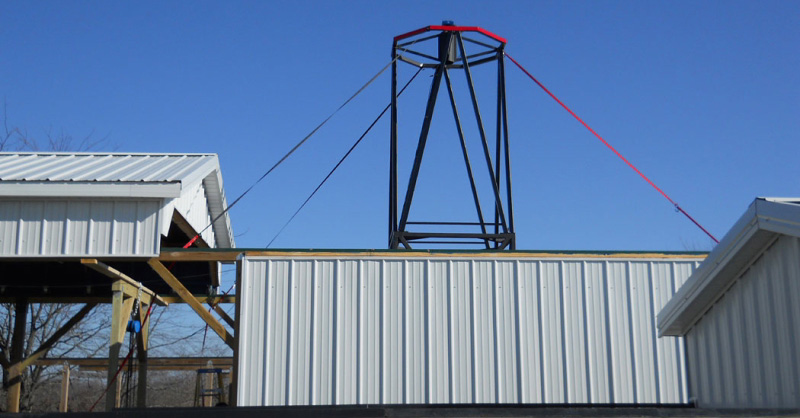 |